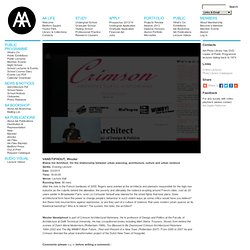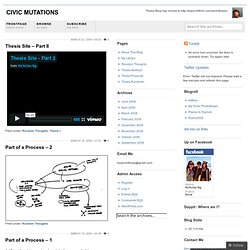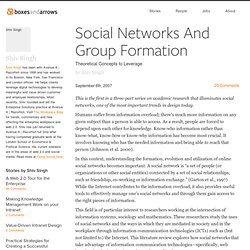

AA SCHOOL OF ARCHITECTURE - Lectures Online. VANSTIPHOUT, Wouter Blame the Architect: On the relationship between urban planning, architecture, culture and urban violence Series: Evening Lecture Date: 3/2/2011 Time: 18:00:00 Venue: Lecture Hall Running time: 90 mins After the riots in the French banlieues of 2005, fingers were pointed at the architects and planners responsible for the high-rise suburbs as the culprits behind the alienation, the poverty and ultimately the violence erupting around French cities.

Just as 20 years earlier in Broadwater Farm, even Le Corbusier himself was blamed for the street fights that took place. Wouter Vanstiphout is part of Crimson Architectural Historians. User Interface: „Das Wichtigste ist Weglassen“ Futurezone: Wenn Sie einen Blick zehn oder auch 20 Jahre in die Zukunft werfen, wie werden Benutzeroberflächen auf unseren Computern dann aussehen?

Werden sie sich stark von heutigen User Interfaces unterscheiden oder geht es künftig nur noch um Details? Peter Purgathofer: Beides. Die Oberflächen „auf unseren Computern“ werden recht ähnlich gestaltet und strukturiert sein, ein bisschen nach dem Motto "never change a winning team". Die Oberflächen auf allen anderen Geräten werden radikal verschieden sein. Auf Tablets sind die Interaktionsformen schon jetzt anders. Welche Trends sehen Sie, die sich künftig durchsetzen könnten? Technisch ist vieles machbar, was gleichzeitig aber nicht immer auch Benutzerfreundlichkeit bedeutet.
CRITICAL ANALYSIS AND DIAGRAMMING. Protest - Urban Design. What makes citizens choose a particular form of protest? How does space function as mediator between these citizens and their political acts? Whose power and control drive negotiations between citizens and regimes during protests? Addressing these questions, this exhibition offers a window into how people use, manipulate, claim, and appropriate urban space while advocating for their own values. It should be noted that the exhibit looks at these issues in a socio-spatial context, without any consideration of moral and political narratives. Complementing existing architectural and planning theories that explore the role of built spaces in constructing national identity, the exhibition investigates urban spaces as cultural artifacts within intricate power geometries. Civic Mutations. Part of a Process – 1 A different thought in searching for a distinctive program that’d be appropriate and provide a stronger argument.

Rather than looking into relationship between users, what is the relationship between the platform and the users themselves. (Top) Facebook Diagram (Top) Twitter Diagram (Top) LinkedIn Diagram (Top) Dating Sites Diagram (i.e. match.com) Filed under: Random Thoughts Thesis Site – Part I Proposed thesis project site. Draft for Intro Working on a draft on what to present for next week. Filed under: Diagram, Random Thoughts, Thesis I The Human Network I’ve been following David Armano’s blog for a while now and find his presentation to be quite informative, and this one below is no exception. Progress: Diagram Looks like the diagram for Twitter is more straightforward than the one for Facebook, but is it communicating what I intended? Update: Added a YouTube Diagram below. Filed under: Diagram, Progress, Random Thoughts Progress: Facebook Diagram v2 Hypotheses? Tangible Media Group. Social Networks And Group Formation. This is the first in a three-part series on academic research that illuminates social networks, one of the most important trends in design today.

Humans suffer from information overload; there’s much more information on any given subject than a person is able to access. As a result, people are forced to depend upon each other for knowledge. Know-who information rather than know-what, know-how or know-why information has become most crucial. It involves knowing who has the needed information and being able to reach that person (Johnson et al. 2000).
In this context, understanding the formation, evolution and utilization of online social networks becomes important. This field is of particular interest to researchers working at the intersection of information systems, sociology and mathematics. The online social network field is broad, and any literature review can only focus on a selection of articles. The Strength of Weak Ties Social networks were first researched in the late 1940s.